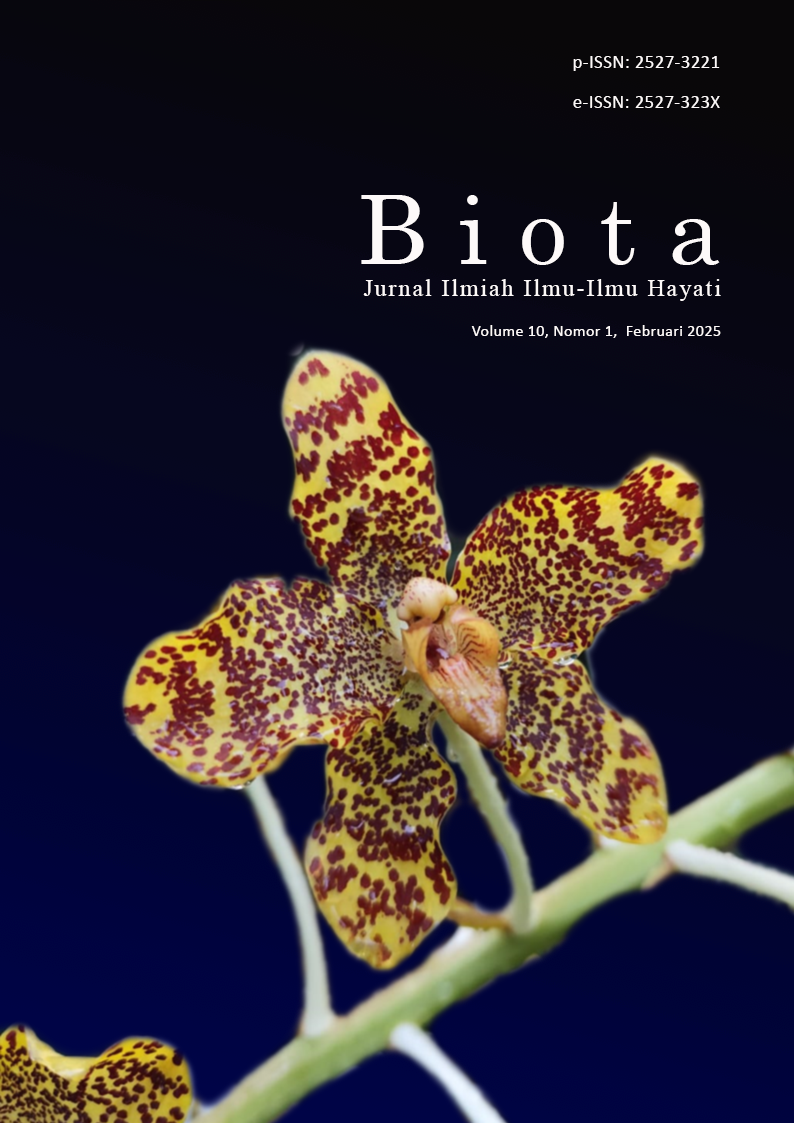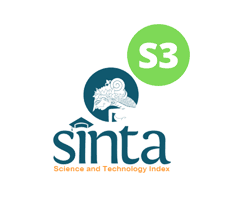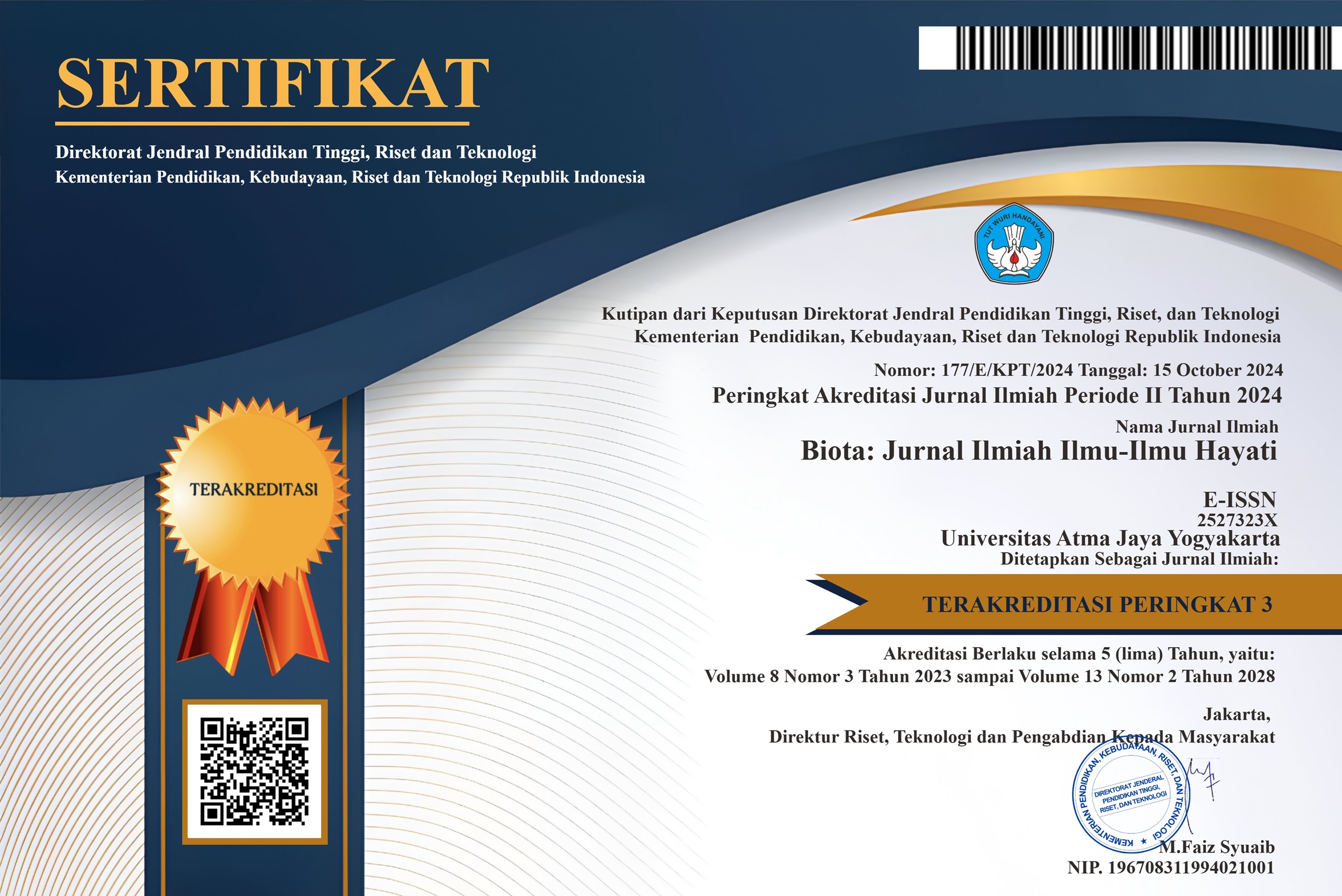Downy Mildew Infection in Indonesian Melon Cultivar 'Melona' Based on Morphological and Anatomical Characters
DOI:
https://doi.org/10.24002/biota.v10i1.8597Keywords:
Downy mildew disease, fungal infection, plant re, resistance levelAbstract
Melons are a horticultural crop of the Cucurbitaceae family with high economic value and worldwide distribution. The 'Melona' variety is the result of breeding selection from commercial melons in Indonesia and has a golden yellow skin color with lobes, crisp flesh, and a high degree of sweetness. Downy mildew is a fungal infection that attacks the leaves of the plant causing brownish-yellow-colored symptoms. Downy mildew can cause crop failure under extreme conditions as the plant loses its productive capacity. Infection levels were observed by scoring and calculating disease index scores. The morphology of healthy and diseased plants was documented and analyzed descriptively. Anatomical features of healthy and diseased leaves were compared using anatomical observations on leaf cross-sections. Quantitative data analysis was carried out using the T-test analysis method with a 5% significance level. Melona's resistance to downy mildew is in the tolerant to susceptible category. Chlorosis and necrotic spots on the leaves and stunted growth are symptoms of downy mildew infection. Healthy leaves had a greater axial and abaxial epidermal thickness, a lower mesophyll thickness, a smaller cell size and a better quantity and quality of trichomes than leaves infected with downy mildew.
References
Alfiani, A. (2017). Perakitan dan Karakterisasi Molekuler Melon Hibrida (Cucumis melo L. ’Melona’). Universitas Gadjah Mada.
Biruliova, E., Prosiannykova, I., & Fedotova, A. (2013). The rust fungus Uromyces geranii (DC.) Lev. Localization and impact on anatomy of the host plant Geranium sanguineum L. Modern Phytomorphology 4: 109–113.
Call, A. D., Wehner, T. C., Holmes, G. J., & Ojiambo, P. S. (2013). Effects of Host Plant Resistance and Fungicides on Severity of Cucumber Downy Mildew. Hortscience 48(1): 53–59.
Crandall, S. G., Rahman, A., Quesada-Ocampo, L. M., Martin, F. N., Bilodeau, G. J., & Miles, T. D. (2018). Advances in Diagnostics of Downy Mildews: Lessons Learned from Other Oomycetes and Future Challenges. Plant Disease 102(2): 265–275.
Daryono, B. S., & Maryanto, D. S. (2018). Keanekaragaman dan Potensi Sumber Daya Genetik Melon. UGM Press: Yogyakarta
Dewi, I. M., Cholil, A., & Muhibuddin, A. (2013). Hubungan Karakteristik Jaringan Daun dengan Tingkat Serangan Penyakit Blas Daun (Pyricularia Oryzae Cav.) pada Beberapa Genotipe Padi (Oryza Sativa L.). Jurnal HPT 1(2): 10-18.
Ferreira, G. F., Baltazar, L. de M., Alves Santos, J. R., Monteiro, A. S., Fraga, L. A. de O., Resende-Stoianoff, M. A., & Santos, D. A. (2013). The role of oxidative and nitrosative bursts caused by azoles and amphotericin B against the fungal pathogen Cryptococcus gattii. Journal of Antimicrobial Chemotherapy 68(8): 1801–1811.
Fukino, N., Kunihisa, M., & Matsumoto, S. (2004). Characterization of Recombinant Inbred Lines Derived from Crosses in Melon. In Breeding Science 54(2): 41–145.
Holdsworth, W. L., Summers, C. F., Glos, M., Smart, C. D., & Mazourek, M. (2014). Development of Downy Mildew-resistant Cucumbers for Late-season Production in the Northeastern United States. HortScience 49(1): 10–17.
Holmes, G. J., Ojiambo, P. S., Hausbeck, M. K., Quesada-Ocampo, L., & Keinath, A. P. (2015). Resurgence of cucurbit downy mildew in the United States: A watershed event for research and extension. Plant Disease 99(4): 428–441.
Innark, P., Ratanachan, T., Khanobdee, C., Samipak, S., & Jantasuriyarat, C. (2014). Downy mildew resistant/susceptible cucumber germplasm (Cucumis sativus L.) genetic diversity assessment using ISSR markers. Crop Protection 60: 56–61.
Ishak, M. A. & Budi Setiadi Daryono. (2020). Identification and Analysis of Powdery Mildew Resistance in Melon (Cucumis melo L.) Cultivar Meloni. Bioeduscience: Jurnal Pendidikan Biologi Dan Sains 4(1): 1–10.
Kubicek, C. P., Starr, T. L., & Glass, N. L. (2014). Plant cell wall-degrading enzymes and their secretion in plant-pathogenic fungi. Annual Review of Phytopathology 52(1): 427–451.
Latifah, Y. W. (2016). Kestabilan Karakter Fenotip dan Molekuler Melon (Cucumis melo L. ’Melona’) Hasil Segregasi dan Seleksi Populasi (Bachelor's thesis). Universitas Gadjah Mada, Yogyakarta.
Lebeda, A., Křístková, E., Sedláková, B., McCreight, J. D., & Coffey, M. D. (2016). Cucurbit powdery mildews: Methodology for objective determination and denomination of races. European Journal of Plant Pathology 144(2): 399–410.
Ni, X., Sun, L., Cai, Q., Ma, S., Feng, Y., Sun, Y., An, L., & Ji, C. (2022). Variation and determinants of leaf anatomical traits from boreal to tropical forests in eastern China. Ecological Indicators 140: 108992.
Ojiambo, P. S., Gent, D. H., Quesada-Ocampo, L. M., Hausbeck, M. K., & Holmes, G. J. (2015). Epidemiology and Population Biology of Pseudoperonospora cubensis: A Model System for Management of Downy Mildews. Annual Review of Phytopathology 53(1): 223–246.
Pradana, A. W., Samiyarsih, S., & Muljowati, J. S. (2017). Korelasi Karakter Anatomi Daun Ubi Jalar (Ipomea batatas L.) Kultivar Tahan dan Tidak Tahan Terhadap Intensitas Penyakit Kudis Daun. Scripta Biologica 4(1): 21-29.
Samiyarsih, S., Erlina, C. A., Muljowati, J. S., & Fitrianto, N. (2022). Histopathological Evaluation of Soybean (Glycine max (L.) Merr.) Strains Resistance to Sclerotium rolfsii Disease. PLANTA TROPIKA: Jurnal Agrosains (Journal of Agro Science) 10(1): 62–68.
Samiyarsih, S., Juwarno, J., & Muljowati, J. S. (2018). The Structural Resistance’s Anatomy of Sweet Potato Leaves to Fungal Pathogen Sphaceloma batatas. Biosaintifika: Journal of Biology & Biology Education 10(1), 131–137.
Schuurink, R., & Tissier, A. (2020). Glandular trichomes: Micro-organs with model status? New Phytologist, 225(6): 2251–2266.
Serrano, M., Coluccia, F., Torres, M., L’Haridon, F., & Métraux, J. P. (2014). The cuticle and plant defense to pathogens. Frontiers in Plant Science 5: 274.
Sun, Z., Yu, S., Hu, Y., & Wen, Y. (2022). Biological Control of the Cucumber Downy Mildew Pathogen Pseudoperonospora cubensis. Horticulturae 8(5): 410.
Taiz, L., Zeiger, E., Moller, I. M., & Murphy, A. (2015). Plant Physiology and Development. Sinauer Associates, Inc: Sunderland.
Thines, M. (2014). Phylogeny and evolution of plant pathogenic oomycetes—A global overview. European Journal of Plant Pathology, 138(3): 431–447.
Torres, A., Langenhoven, P., & Behe, B. K. (2020). Characterizing the U.S. Melon Market. HortScience 55(6): 795–803.
Wang, M., Sun, Y., Sun, G., Liu, X., Zhai, L., Shen, Q., & Guo, S. (2015). Water balance altered in cucumber plants infected with Fusarium oxysporum f. Sp. Cucumerinum. Scientific Reports 5(1): 7722.
Wen, D. M., Chen, M. X., Zhao, L., Ji, T., Li, M., & Yang, X. T. (2019). Use of thermal imaging and Fourier transform infrared spectroscopy for the pre-symptomatic detection of cucumber downy mildew. European Journal of Plant Pathology 155(2): 405–416.
Yusuf, A. F., Alfiyani, A., Salsabila, T. A. S., Kusnanda, P. S., Hidayati, I. N., & Daryono, B. S. (2023). Assessment of maturity stage and stability of new Indonesian melon cultivar ‘Melona’ based on ISSR markers and morphological characteristics. Biodiversitas 24(1): 308-316.
Zheng, L., Gu, C., Cao, J., Li, S., Wang, G., Luo, Y., & Guo, J. (2018). Selecting Bacterial Antagonists for Cucurbit Downy Mildew and Developing an Effective Application Method. Plant Disease 102(3), 628–639.
Downloads
Published
How to Cite
Issue
Section
License
Copyright (c) 2025 Bunga Finovel Angellya, Adib Fakhruddin Yusuf, Wiko Arif Wibowo, Budi Setiadi Daryono

This work is licensed under a Creative Commons Attribution-NonCommercial 4.0 International License.
Authors who publish with Biota : Jurnal Ilmiah Ilmu-Ilmu Hayati agree to the following terms:
- Authors retain copyright and grant the Biota : Jurnal Ilmiah Ilmu-Ilmu Hayati right of first publication. Licensed under a Creative Commons Attribution-NonCommercial 4.0 International License that allows others to share the work with an acknowledgment of the work's authorship and initial publication in this journal.
- Authors are able to enter into separate, additional contractual arrangements for the non-exclusive distribution of the journal's published version of the work (e.g., post it to an institutional repository or publish it in a book), with an acknowledgment of its initial publication in Biota : Jurnal Ilmiah Ilmu-Ilmu Hayati, and as long as Author is not used for commercial purposes.













